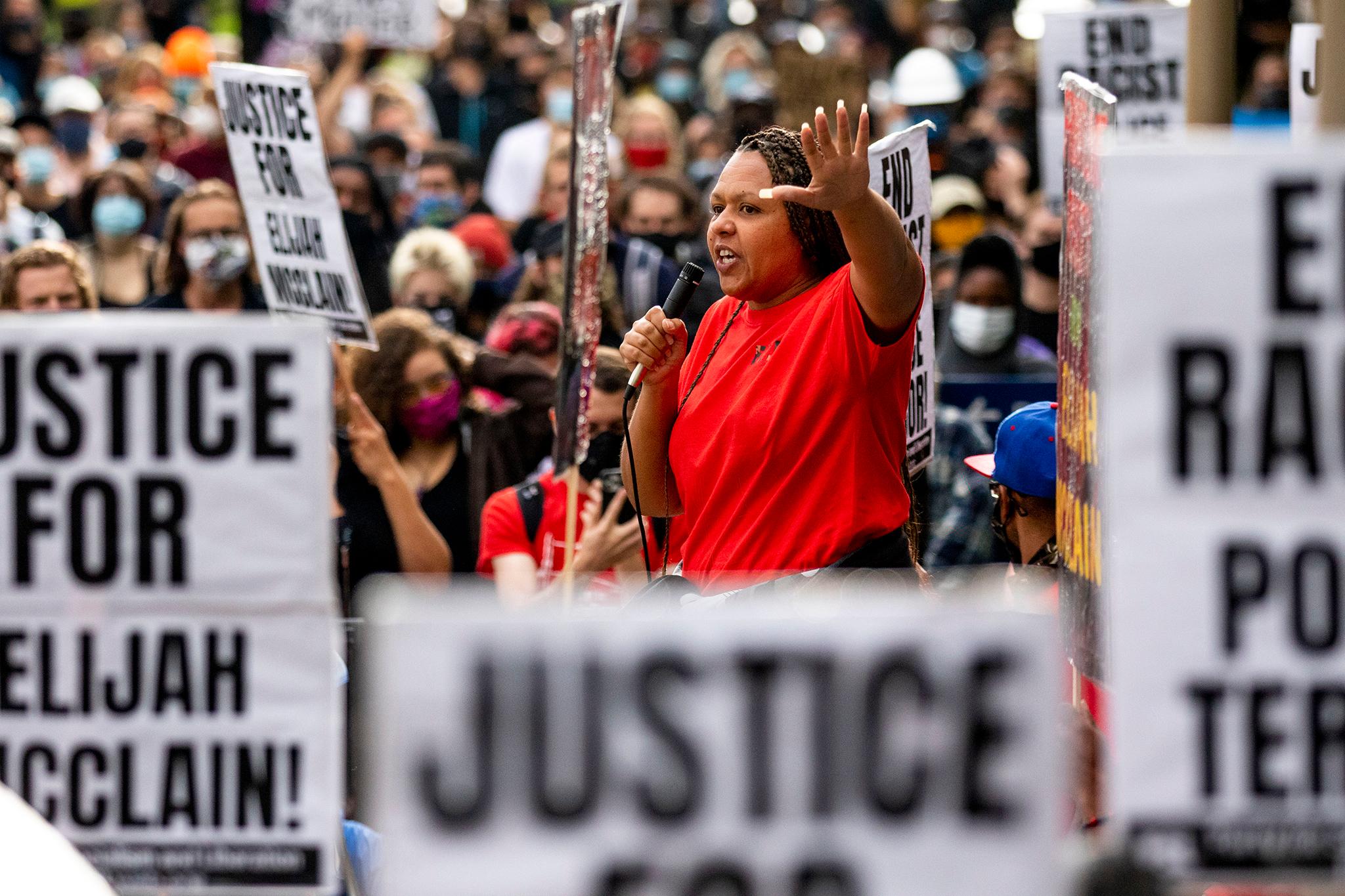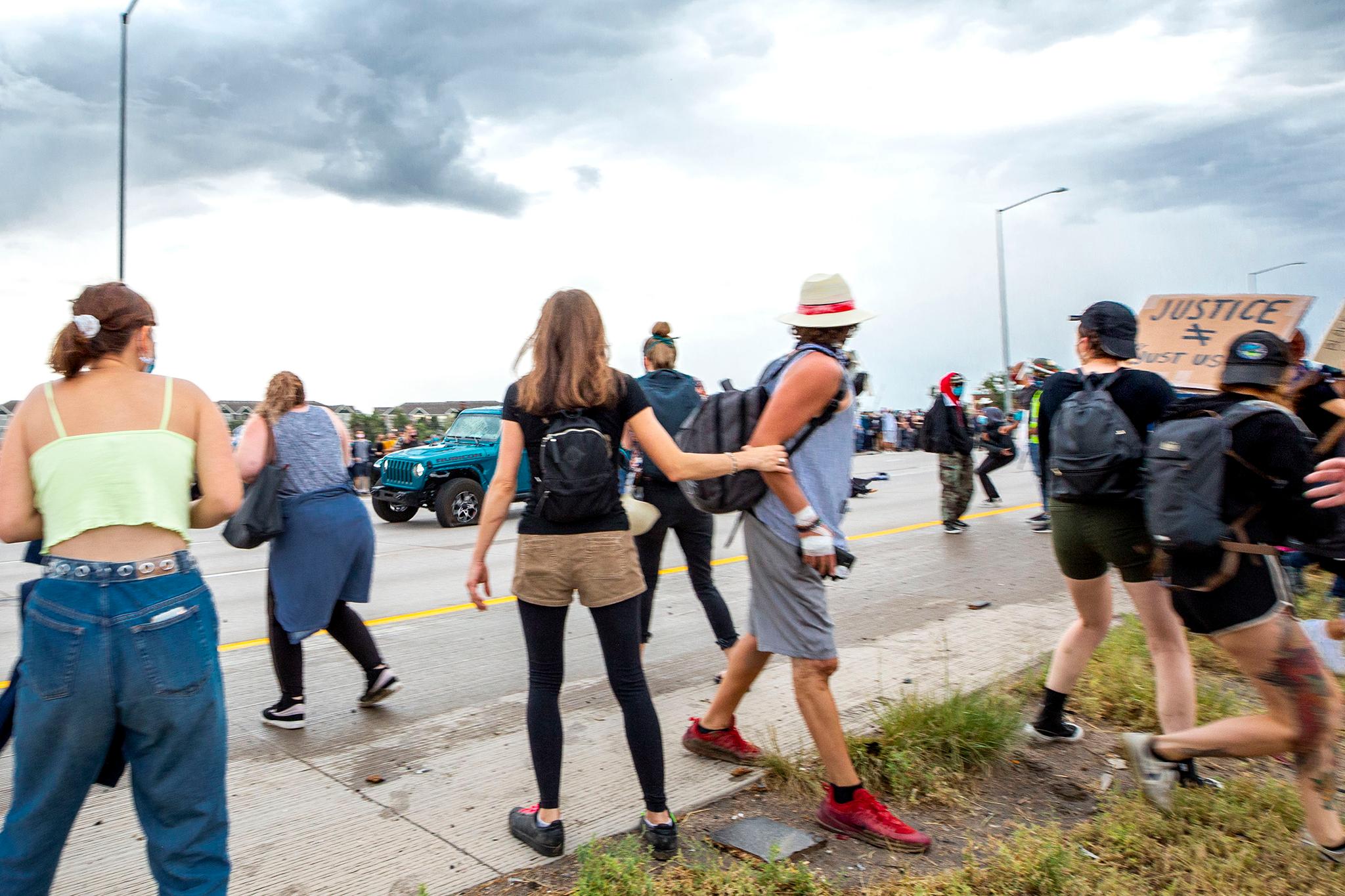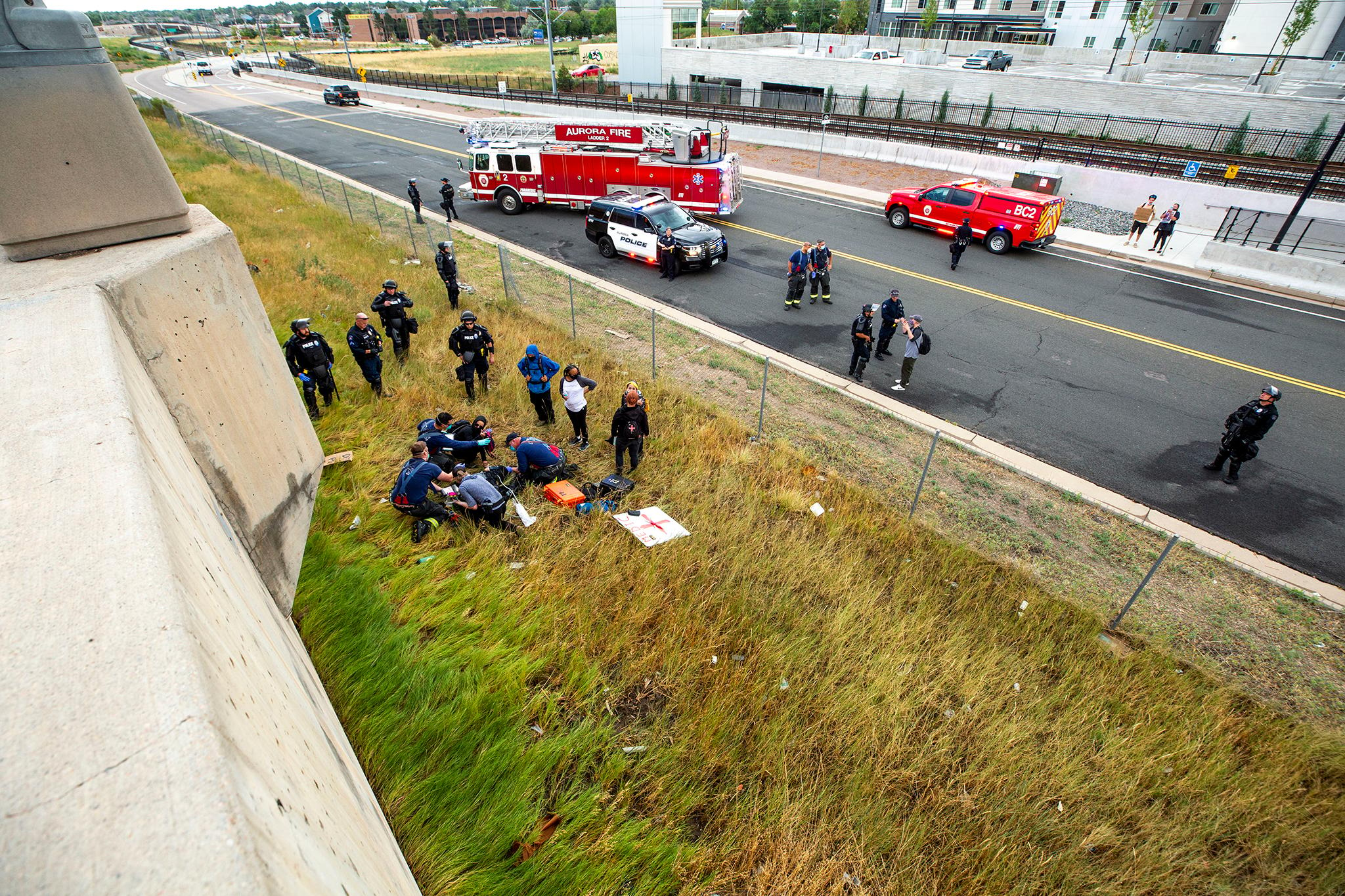Updated 11:03 p.m.
Around 5 p.m. outside the Aurora Police Department headquarters on Alameda Parkway, protesters began to gather in raincoats, carrying umbrellas, to continue demands for accountability in the death of Elijah McClain.
A couple of hours into the protest, as demonstrators marched and blocked traffic on I-225, a driver tried to plow into them. A protester fired a gun and struck another protester, who was sent to the hospital in stable condition. Later in the evening, as the crowd dwindled, some people who remained took down a fence at the Aurora Municipal Center and broke into the courthouse, according to police.
The "Elijah Still Needs Justice!" rally was organized by the Party for Socialism and Liberation, the Frontline Party for Revolutionary Action and Aurora Copwatch. Attendees are upset that 11 months after McClain's death, no officers lost their jobs, or were removed from patrol, over his death. Last August, police approached McClain on the street as he had been walking to the store. He wasn't accused of any crime. Officers put him in a carotid hold around his neck and medical technicians used ketamine to sedate him. McClain later died in the hospital.
Almost a year later, rally organizers still have questions about some aspects of city departments' handling of McClain's death, like why police officers were allowed to be present at the autopsy and why the autopsy listed the cause of death as "inconclusive," which made it nearly impossible to charge anyone. Investigations into McClain's death are underway at the city, state and federal levels.

Three officers were fired after a photo surfaced that mocked the carotid hold used on McClain, taken at the place where McClain was first apprehended. All three have appealed their cases. Protesters want to keep up pressure on officials to deny those appeals.
Saturday's rally takes places as Aurora Police face a class-action lawsuit over their treatment of protesters nearly a month ago, also at the Aurora Municipal Center. Also, demonstrators wanted to show solidarity with their counterparts in Portland, OR, where federal agents have pulled protesters off the streets in unmarked cars. As protesters prepared to march in Aurora Saturday, they were ready for potential uses of force by police, but there was very little police presence on scene.

Instead, at 6:45 p.m., after protesters moved onto I-225, things got chaotic. A teal colored Jeep sped through the crowd where protesters walked on the highway. Joel Ibrahim, who helped organize the rally for justice, said it appeared the Jeep was going 80 miles per hour and was "clearly looking to do some damage." He said attempted hit-and-runs have been a common tactic to try to hurt people demonstrating against racism and police violence.
Ibrahim said the car would have plowed through a group of people, but another driver, Sebastian Sassi, pulled in front to slow the Jeep's progress. As the driver of the Jeep attempted to leave, Ibrahim said, the car's tires popped. "Somebody in the crowd tried to subdue the driver. The driver did get away. Somebody got hurt in the process."


People heard bangs that sounded like they could have been fireworks or gunshots. Aurora Police confirmed a protester fired a weapon, "striking at least 1 other protester. They were transported to the hospital in stable condition." A demonstrator named Jessi Lee said she saw a man fire a handgun, and that other protesters were angry he had shot. Ibrahim and Lee both said the person fired in response to the car trying to drive through the demonstration.
Ibrahim said he's generally not concerned that guns may be present at marches.
"I'm concerned if people don't have any sort of discipline," he told Denverite. "But firearms themselves, no. We believe that the working class people should be armed against oppressors."
Police said the Jeep was towed into their custody. Though a video shows police talking to someone who appears to be the driver, a spokesperson said no one has been arrested. They asked that anyone with information about what happened call Metro Denver Crime Stoppers.
A woman also fell off the highway during the chaos. She was treated by EMTs and carried into an ambulance on a stretcher and in a neck brace.



At least five people at the protest were seen carrying firearms. Protesters left the highway by 7:45 p.m. and returned to the Aurora Municipal Center. Most people left by 8:30 p.m., after Ibrahim told the crowd he was calling it a night. He asked people leave in groups to avoid contact with police or federal officers.
Aurora Police said some remaining protesters pushed down a newly-erected fence protecting police headquarters and shot off fireworks. APD say the diminished group of protesters then pushed their way into the courthouse and attempted to start fires. Officers declared it an unlawful assembly just before 9 p.m. and ordered people to disperse. They said they had put out a fire inside the courthouse.
On Sunday morning, Aurora Police said more than 20 courthouse windows had been smashed.

(Kevin J. Beaty/Denverite)
The metro has seen months of ongoing demonstrations since George Floyd was killed by Minneapolis police in May.
Though recent demonstrations have not been as large as the weeks immediately following Floyd's killing, when thousands took to the streets and faced multiple police agencies throwing tear gas near the state Capitol building, dedicated activists have counted the uninterrupted days of action since those initial protests.
Actions have demanded justice for local citizens like McClain, William DeBose and others who died during interactions with police. Denver City Council meetings have been disrupted by protests. When the council canceled a meeting, activists held their own forum on the City and County Building steps.
Even in days without marches, protest camps calling for police accountability have kept their demands visible.
One lasted for a few weeks outside of the Governor's Mansion on 8th Avenue in Denver. They marched most nights in small groups though Denver's streets, stopping traffic for 8 minutes and 46 seconds, the length of time an officer knelt on Floyd's neck in Minnesota, killing him.
Activists used the time to distribute flyers to their captive audience. "DEFUND THE POLICE" was printed on every one, along with figures showing Denver spent more than a quarter of its budget on public safety in 2019. The flyers also include a list of "black-centered demands" - that money from Denver and Aurora police departments be redirected to support "Black businesses, Black school districts and Black community programs."

The camp outside of the Governor's Mansion moved Thursday night after Denver signed an agreement with state police, allowing state Troopers to enforce the city's camping ban on state property.
Brian Loma, a longtime activist and documentarian representing Occupy Denver, said campers were concerned the governor might authorize federal troops to clear them out. Polis told press Thursday that he has not asked federal agents to come to Colorado, as they have in Portland, Oregon, though he did encourage Denver's police to clear encampments on state property.
"They are welcome to come onto our property and remove tents. Not only welcome. I would encourage [them]," he said. "If there are anybody who are squatted on state property, we encourage anybody, law enforcement agency, of course to come remove them."
Though Polis has not requested federal troops, and though Denver Mayor Michael Hancock signed a letter with 13 other mayors demanding federal agents leave U.S. cities, the fear that they may materialize has stoked recent protests.


A couple hundred people gathered on the Capitol steps Friday evening demanding racial justice and resistance to President Trump's use of federal officers. Before it began, some protesters shouted to others that they should turn off their phones' GPS, lest they be tracked by the government.
"Federal agents have been spotted in Denver," one shouted. "They're taking your pictures! They're in the trees!"
There is no evidence to support those claims in Denver.
The ensuing march Friday night was larger than those in past weeks. The crowd marched into Five Points, then to a federal courthouse downtown where they hoisted an upside-down American flag to the top of the pole outside.












